Physical Address
304 North Cardinal St.
Dorchester Center, MA 02124
To appreciate the pathogenesis of sinusitis, you must understand the normal anatomic pathways of mucociliary clearance in the paranasal sinuses ( Fig. 12-1 ). The cilia within the maxillary sinus propel the mucous stream in a starlike pattern from the floor of the maxillary sinus toward the ostium situated superomedially. In approximately 30% of patients, a second accessory ostium to the maxillary sinus is present inferior to the major opening. From the maxillary sinus ostium, mucus from the maxillary antrum (the maxillary antrum and maxillary sinus are synonymous) gets swept superiorly through the infundibulum, which is located lateral to the uncinate process and medial to the inferomedial border of the orbit. The uncinate process, a sickle-shaped bony extension of the lateral nasal wall extending anterosuperiorly to posteroinferiorly, is rarely (<2.5% of patients) pneumatized itself. Occasionally, the uncinate process attaches to the lamina papyracea (the medial wall of the orbit). If it does so, the infundibulum does not have a superior opening, thus creating a blind pouch, the recessus terminalis. The hiatus semilunaris is a slitlike air-filled space anterior and inferior to the largest ethmoid air cell, the ethmoidal bulla, and right above the uncinate process. Mucus is passed through the hiatus semilunaris posteromedially via the middle meatus, a channel between the middle turbinate and the uncinate process, into the back of the nasal cavity to the nasopharynx where it is subsequently swallowed (blech!) or expelled (yuck!).
The ostiomeatal complex (OMC) refers to the maxillary sinus ostium, the infundibulum, the uncinate process, the hiatus semilunaris, the ethmoid bulla, and the middle meatus; this is the common drainage pathway of the frontal, maxillary, and anterior ethmoid air cells.
The frontal sinuses drain inferomedially via the frontal recess (previously termed the frontoethmoidal recess or frontonasal duct). The frontal recess connotes the common drainage of the frontal sinus and the anterior ethmoid air cells. The frontal recess is the space between the inferomedial frontal sinus and the anterior part of the middle meatus. The frontal sinus and the anterior ethmoid air cells usually drain directly into the middle meatus via the frontal recess, or less commonly into the superior ethmoidal infundibulum, before passing to the middle meatus.
Several ethmoidal air cells have specific names. The most anterior ethmoid air cells located anterior, lateral, and below the frontal recess are termed agger nasi cells. They are present in more than 90% of patients ( Fig. 12-2 ). The ethmoidal bulla is the term used for the ethmoid air cell directly above and posterior to the infundibulum and hiatus semilunaris. A very large ethmoidal bulla can obstruct the infundibulum and hiatus semilunaris, and lead to interference with the drainage of the maxillary and anterior ethmoid sinuses. When anterior ethmoid air cells are located inferolateral to the bulla, along the inferior margin of the orbit protruding into the maxillary sinus, they are termed Haller cells, also known as maxilloethmoidal cells or infraorbital cells. They are seen in 10% to 45% of patients. When greatly enlarged, Haller cells may narrow the infundibulum or maxillary sinus ostium ( Fig. 12-3 ). Between the ethmoidal bulla and the basal lamella (the lateral attachment of the middle turbinate to the lamina papyracea of the orbit) is the sinus lateralis. The sinus lateralis, comprising the suprabullar and retrobullar recesses, may open into the frontoethmoidal recess or into a space posterior to the bulla, the hiatus semilunaris posterioris.
The posterior ethmoid air cells are located behind the basal lamella of the middle turbinate and drain via the superior meatus, the supreme meatus, or other tiny ostia just under the superior turbinate, which ultimately drain along with the sphenoid sinuses into the sphenoethmoidal recess of the nasal cavity ( Fig. 12-4 ), from which the secretions pass to the nasopharynx. In some patients the most posterior ethmoid air cell may pneumatize into the sphenoid bone, superior to the sphenoid sinus. This is termed an Onodi cell . Its importance is that, if perforated surgically, it may lead intracranially or into the optic canal.
The roof of the ethmoid sinus is termed the fovea ethmoidalis, which merges medially with the cribriform plate.
The nasal cavity typically has three sets of turbinates: the superior, middle, and inferior turbinates. Occasionally, a fourth superiormost turbinate can be seen, the supreme turbinate. An aerated middle turbinate, which usually communicates with the anterior ethmoid air cells, is termed a concha bullosa and is seen in approximately 34% to 53% of patients. Most people believe that, unless huge, the presence of a concha bullosa does not predispose to chronic sinusitis. Significant pneumatization of the inferior or superior turbinates is much less common (<10% of patients). Reversal of the characteristic medially directed curve of the middle turbinates is described as “paradoxical.”
The nasal septum is the midline structure between the right and left turbinates. The nasal septum is composed of three parts: a cartilaginous anteroinferior portion; a bony posteroinferior portion known as the vomer; and a superoposterior bony portion, the perpendicular plate of the ethmoid bone. The nasal septum is aerated only rarely. Nasal septal deviation, however, is common, and bony spurs often develop at the apex of the deviation. Spurs may cause the sensation of nasal obstruction.
The nasolacrimal duct courses downward from the lacrimal sac bordering the medial canthus, where it is in close association with agger nasi air cells. Inflammation of agger nasi cells may be associated with epiphora because of this close relationship. The duct subsequently runs in the anterior and inferior portions of the lateral nasal wall. Its ending opens below the inferior turbinate at the inferior meatus.
Remember the development of the sinuses by the mnemonic: Embattled Military Fought Saddam (ethmoid, maxillary, frontal, sphenoid).
The ethmoid sinuses are present at birth. Rapid expansion of the ethmoid air cells occurs during ages 0 to 4 years and again with the adolescent growth spurt from 8 to 12 years. The ethmoid sinus is usually the source of infection in childhood sinusitis. This may also lead to orbital cellulitis or subperiosteal orbital abscesses in children.
The maxillary antrum is also present, although small at birth, and growth continues to age 14 years.
The frontal sinus is not present at birth but pneumatization evolves from age 1 to 12 years. Growth over the orbital roof usually occurs from ages 4 to 8 years. Frontal sinusitis before age 4 years is therefore rare.
The sphenoid sinus begins its pneumatization at approximately age 2 years and the growth is slower and more delayed than the other sinuses. The ultimate size of the sphenoid sinus is quite variable.
Note that the OMC is developed at birth and functional endoscopic sinus surgery (FESS) is an option for chronic childhood sufferers of sinusitis. Similarly, the mucosa in the infant is somewhat redundant and up to 60% of asymptomatic infants can have complete or near complete opacification of their sinuses. Therefore, mucosal thickening should not be assumed to be due to sinusitis.
Sinonasal imaging has progressed methodically as each new generation of imaging modality has encroached on the domain of the former generation. Although plain films once served as the most commonly ordered study to evaluate the sinonasal cavity, computed tomography (CT) has now supplanted plain films, because the endoscopic sinus surgeon has required greater anatomic precision. During the 1970s and 1980s, FESS replaced the more traditional Caldwell-Luc and maxillary antrostomy procedures for treating chronic sinusitis.
FESS is done via an intranasal endoscope rather than with an external approach, so surgeons must know where they are at all times, to prevent complications such as orbital or intracranial entry, particularly when they are operating posteriorly in the sinonasal cavity. CT serves as the road map for this procedure. The goal of FESS is to maintain the normal mucosa of the sinonasal cavity and to preserve the natural pathway of mucociliary clearance. FESS does not attempt to strip the mucosa clean as was sometimes performed in a Caldwell-Luc procedure, so mucociliary motility is preserved. Also, rather than creating an alternate egress of mucus from the maxillary sinus, as in an inferior maxillary antrostomy (the Caldwell-Luc procedure), FESS enlarges the natural ostia and passageways of the paranasal sinuses. Whereas in the past maxillary and frontal sinusitis were thought to be the primary processes in patients with chronic sinusitis, it is now believed that these sinuses are secondarily obstructed because of disease in the OMC. The classic theory of FESS is that disease at the ostium and inferior infundibulum obstructs the maxillary sinus, whereas disease in the middle meatus and posterior infundibulum obstructs the frontal and anterior ethmoid air cells. Therefore, surgery is directed toward removing potential obstacles to mucociliary clearance at the OMC. Therefore amputation of the uncinate process, enlargement of the infundibulum and maxillary sinus ostia, and creation of a common unobstructed channel for the anterior ethmoid air cells are common practices in FESS. Usually FESS also includes complete or partial ethmoidectomies.
There are four potential dehiscent areas where the FESS surgeon can get into anatomic (and medicolegal) trouble: (1) cribriform plate with inadvertent entry intracranially leading to cerebrospinal fluid (CSF) leak/brain damage, (2) lamina papyracea with puncture into the orbit leading to expanding intraorbital hematoma, (3) sphenoethmoidal junction with the optic canal with potential optic nerve injury, and (4) sphenoid sinus lateral wall with possible carotid artery injury/pseudoaneurysm. Make sure you check each case for intact walls in these four areas.
For the FESS surgeon, coronal CT is ideal because it simulates the appearance of the sinonasal cavity from the perspective of the endoscope. At present, coronal reconstructions of axial CT data from multidetector spiral CT scans are just as good as direct coronal images and may be able to eliminate some dental amalgam artifact that otherwise is present. To eliminate the effects of reversible sinus congestion, patients undergoing CT for evaluation of chronic sinus disease are best scanned 4 to 6 weeks after medical therapy and not during an acute infection. Some radiology departments also administer nasal spray decongestants or antihistamines to reduce reversible mucosal edema before the patients are placed in the scanner. Even with this preparation, surgeons claim that in approximately 10% of cases with “normal CT scans” they find endoscopic evidence of significant sinusitis. This goes to show that imaging diagnosis of acute sinus inflammation is not always accurate, and the diagnosis of sinusitis remains a clinical one.
Magnetic resonance (MR) examination of the sinonasal cavity can be performed in a standard head coil or, for more precise anatomic resolution, with a surface coil placed over the anterior part of the face. Both T1-weighted imaging (T1WI) and T2-weighted imaging (T2WI) are required because of the variability of signal intensity of sinonasal secretions caused by protein concentration. Fat-suppressed contrast-enhanced T1WI are employed for the evaluation of complicated sinusitis or for suspected neoplastic disease. Differentiating tumors from infections of the sinonasal cavity may be best achieved with enhanced MR: infected mucosa enhances in a peripheral manner, whereas tumors usually enhance solidly and centrally ( Fig. 12-5 ).
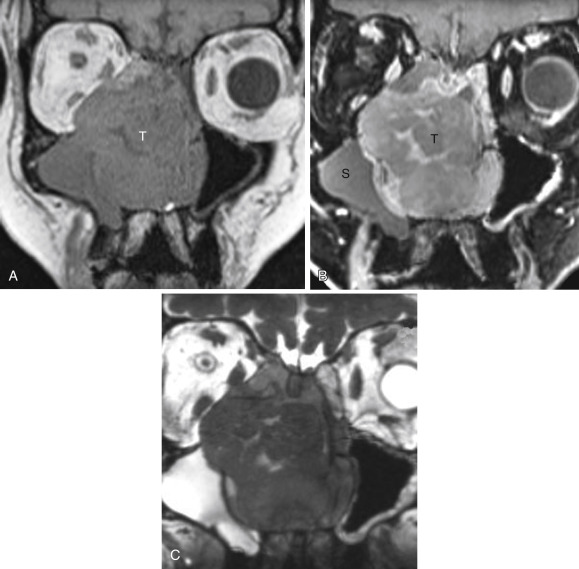
The piriform aperture of the nasal cavity can be narrowed congenitally. A width of less than 11 mm is indicative of congenital nasal piriform aperture stenosis. Abnormal dentition and a midline bony inferior palatal ridge are associated imaging findings. The most common anomalies that result in infantile airway compromise include posterior choanal stenoses and atresias, dacryocystoceles, and stenosis of the piriform nasal aperture.
Choanal atresia is usually diagnosed in infancy because neonates are obligate nose breathers as they suck on a bottle or breast ( Box 12-1 ). The child presents with respiratory distress. Although the diagnosis can be suggested by the inability to pass a nasogastric tube through the nose, imaging is necessary to determine whether the obstruction is membranous (15% of cases) or bony (85%) and whether other congenital central nervous system (CNS) or non-CNS anomalies are associated (50%). In addition to the narrowed posterior choana, look for thickening of the vomer ( Fig. 12-6 ). The posterior choanal opening should be greater than 0.5 cm in width in neonates and 1 cm in adolescents. The vomer should measure less than 0.3 cm in children younger than 8 years old. Rather than atresia, some patients have mere stenosis of the passageway. Often, unilateral choanal atresia may escape detection into adulthood. Patients may be unaware of the hyposmia often associated with this disorder. A dacryocystocele or piriform aperture stenosis may mimic choanal atresia clinically.
Achondroplasia
Fetal alcohol syndrome
CHARGE syndrome (coloboma, heart defects, choanal atresia, retardation, genitourinary abnormalities, ear abnormalities)
Crouzon syndrome
Apert syndrome
Holoprosencephaly
Treacher Collins syndrome
Amniotic band syndrome
Thalidomide embryopathy
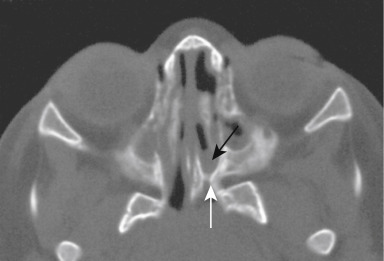
There are several congenital lesions of the sinonasal cavity, including congenital encephaloceles, dermoid/epidermoid cysts, sinus tracts, and nasal gliomas ( Table 12-1 ). These lesions occur as an abnormality in the process of invagination of the neural plate. In embryogenesis, the dura of the brain contacts the dermis at the nasion region as the neural plate retracts. Normally, the dermal connection regresses; when it does not, one of the lesions cited earlier may develop. A CSF connection to the intracranial contents is maintained with meningoencephaloceles, whereas the connection is fibrous only with a nasal glioma ( Figs. 12-7, 12-8 ). Nasal gliomas are not neoplasms but congenital anomalies. They are extranasal more commonly than intranasal. (What an oxymoron—nasal gliomas are usually extranasal and are not gliomas!) Most patients with dermal sinus tracts have a pit in the middle of the nose. Dermoid cysts occur more commonly than tracts; however, tracts may cause more severe symptoms because of their intracranial connection in 25% of cases. Thus meningitis, osteomyelitis, and intracranial abscesses may occur in the setting of dermoid tracts. Epidermoids do not have hair/fat/other dermal elements and are more cystic.
| Lesion | Imaging Findings | Clinical Examination | Treatment |
|---|---|---|---|
| Nasal glioma | Soft-tissue mass with characteristics of the brain No connection or fibrous connection to the brain or CSF |
Intranasal or extranasal mass | Excision |
| Dermoid/epidermoid | Variably cystic/soft-tissue mass ±Sinus tract Inflammatory changes |
Nasal dimple Sinus tract |
Exploration and excision |
| Encephalocele | Connection to CNS with associated defect in skull bone Brain or meninges included Other CNS anomalies |
Pulsatile mass Dural covering |
Patch dura Reduce brain tissue |
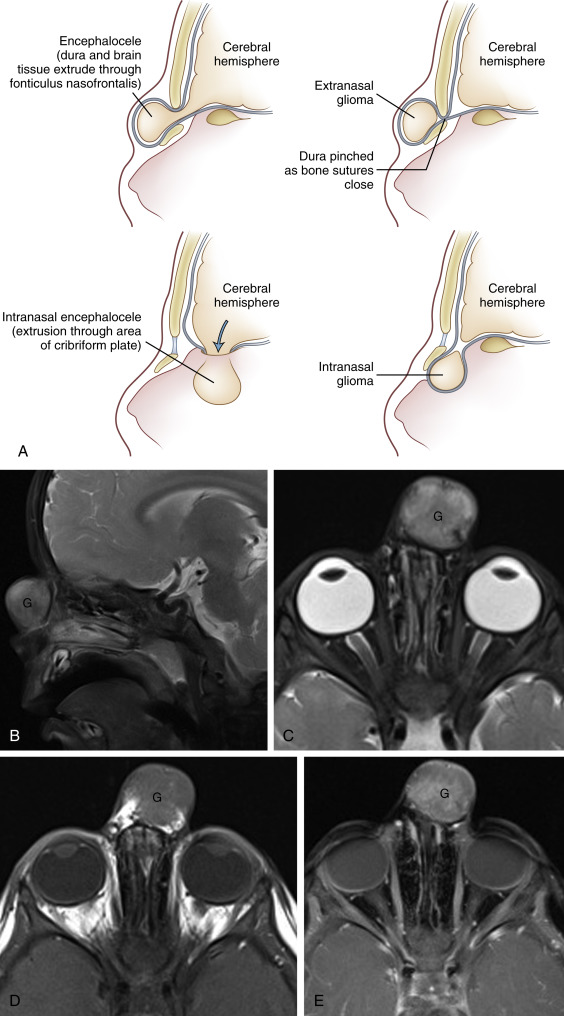
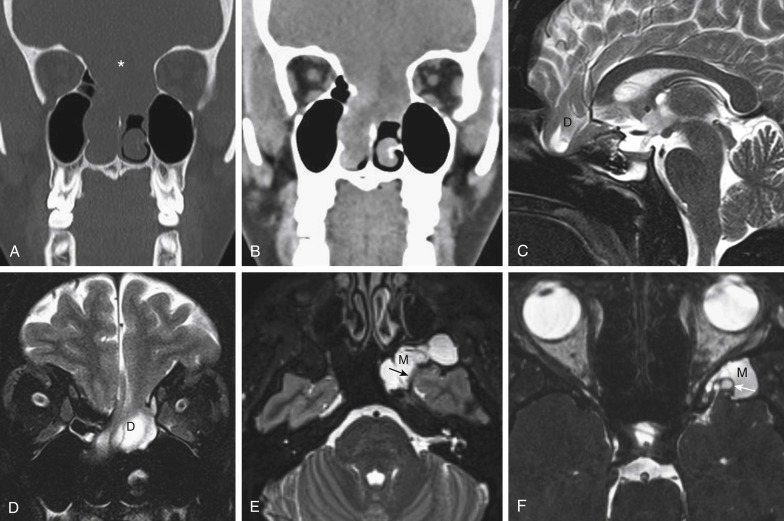
Congenital hypoplasia of the maxillary sinus occurs in 9% of patients. Bony changes that suggest the diagnosis of a hypoplastic antrum are listed in Box 12-2 . Causes of over expansion of paranasal sinuses are listed in Box 12-3 . In the differential diagnosis of sinus hypoplasia is the “silent sinus syndrome” or maxillary sinus atelectasis. In this entity, ostial obstruction from chronic sinusitis leads to chronic negative pressure, which leads to hypoventilation, which, over time, reduces the volume of the sinus, hence “sinus atelectasis.” Patients present with enophthalmos (not sinus symptoms strangely enough) as the orbital floor becomes depressed, the maxillary walls retract centripetally, and expanded retromaxillary fat fills the space left by the atelectatic sinus. CT shows the retracted maxillary sinus walls in association with a small volume, opacified sinus and hypoglobus with enophthalmos ( Fig. 12-9 ).
Downward sloping antral roof
Enlarged ipsilateral nasal cavity
Lower ipsilateral orbital floor
Thickened lateral antral wall
Normal variant
Marfan syndrome
Turner syndrome
Acromegaly
Pneumosinus dilatans from meningioma
Dyke-Davidoff-Masson syndrome (usually unilateral with ipsilateral atrophic brain)
Homocystinuria
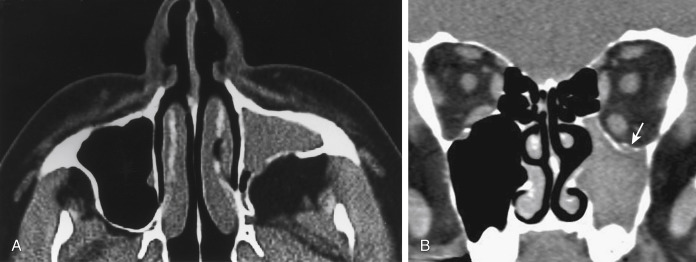
Sinusitis ranks as one of the most common afflictions in the United States. It is estimated that more than 31 million people in the United States are affected by sinus inflammatory disease each year and that 16 million visits to primary care physicians annually are for sinusitis and its complications. Adults average two to three colds per year, and 0.5% of viral upper respiratory infections are complicated by sinusitis. Overall, Americans spend more than $150 million per year for over-the-counter cold and sinusitis medicines, $100 million of which is for antihistamine medications.
Most cases of acute sinusitis are related to an antecedent viral upper respiratory tract infection. With mucosal congestion as a result of the viral infection, apposition of mucosal surfaces results in obstruction of the normal flow of mucus, which results in retention of secretions, creating a favorable environment for bacterial superinfection. The ethmoid sinuses are most commonly involved in sinusitis, possibly because of their position in the “line of fire” as inspired particles collide with and irritate the fragile ethmoid sinus lining.
The bacterial pathogens responsible for acute sinusitis include Streptococcus pneumoniae, Haemophilus influenzae, β-hemolytic streptococcus, and Moraxella catarrhalis . In the chronic phase Staphylococcus, Streptococcus, corynebacteria, Bacteroides, fusobacteria, and other anaerobes may be responsible. The fungi that may infect the sinuses include Aspergillus, Mucor, Bipolaris, Drechslera, Curvularia, and Candida .
The diagnosis of acute sinusitis is a clinical one, and imaging is typically not required. Imaging can be performed to evaluate for recurrent sinus infections or atypical sinus infections, often with the intention of surgical intervention.
Several issues must be addressed when a patient’s CT is evaluated before FESS. Is the uncinate process apposed to the medial orbital wall (an atelectatic infundibulum)? If so, its vigorous removal may result in orbital penetration. Are there areas of dehiscence in the lamina papyracea, or do the orbital contents protrude into the ethmoid sinus (both of which may lead to unintentional orbital entry from the ethmoid sinus)? Defects in the lamina papyracea have been reported in 5% to 10% of autopsy specimens. Because orbital hematomas are the most common orbital complication of FESS, it is important to identify any gaps in the lamina papyracea. CT is the best means for identifying the thin medial bony wall of the orbit.
Are there areas of dehiscence in the cribriform plate and sphenoid sinus walls ( Fig. 12-10 )? Remember that there is an attachment of the middle turbinate to the cribriform plate and that the carotid canal courses along the sphenoid sinus walls. If the surgeon tugs too hard, the cribriform plate will fall and down will come CSF and/or the brain through the new foramen in the skull base. The potential for intraorbital, intracranial, carotid, or optic nerve perforation at the time of surgery depends on these anatomic variants, found in 4% to 15% of patients. Three percent of people have optic nerves that are in contact with the posterior ethmoid wall—most course along (90%) or through (6%) the sphenoid sinus. There have been limited reports of optic nerve transection during sphenoethmoidectomy from an intranasal approach, and dehiscence of the sphenoid wall may be a predisposing factor. An intersinus septum in the sphenoid sinus that attaches to the carotid canal is important to recognize preoperatively and is typically best identified in the axial view ( Fig. 12-11 ). Overvigorous removal of such an intersinus septum during surgery may result in carotid laceration, a real bloody mess.

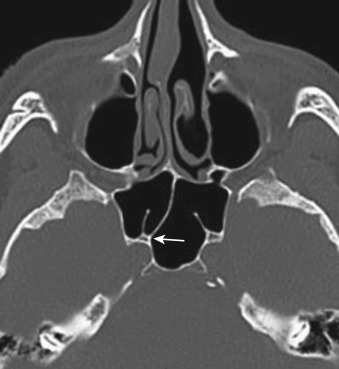
In addition to commenting on the normal anatomic variations in the CT report, the radiologist should identify areas of mucosal thickening and sinus passageway opacification. It has come to be accepted that the location of sinusitis is more important in producing a patient’s symptoms than the extent of the sinusitis. Therefore, a subtle area of opacification in the infundibulum of the OMC may cause more pain and discomfort than nearly complete opacification of the maxillary sinus with a mucous retention cyst and/or polyp.
OMC opacification correlates well with the development of sinusitis ( Fig. 12-12 ). The positive predictive value of infundibular opacification for the presence of maxillary sinus inflammatory disease is approximately 80%. When the middle meatus is opacified, the maxillary and ethmoid sinuses show inflammatory change in 84% and 82% of patients, respectively. The specificity of middle meatus opacification for maxillary or ethmoid sinus disease is more than 90%. These findings support the contention that obstruction of the narrow drainage pathways leads to subsequent sinus inflammation.
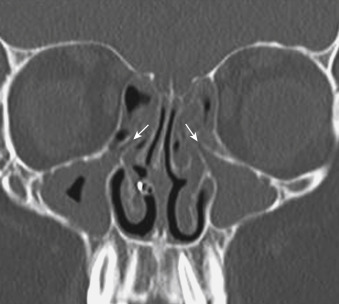
Some head and neck radiologists categorize recurrent inflammatory sinonasal disease into five patterns: (1) infundibular, (2) ostiomeatal unit, (3) sphenoethmoidal recess, (4) sinonasal polyposis, and (5) sporadic or unclassifiable disease. The infundibular pattern is seen in 26% of patients and refers to isolated obstruction of the inferior infundibulum, just above the maxillary sinus ostium. Limited maxillary sinus disease often coexists with this pattern, whereas the ostiomeatal unit pattern, seen in 25% of cases, often has concomitant frontal and ethmoidal disease. The ostiomeatal unit pattern is designated when middle meatus opacification is present. Sphenoethmoidal recess obstruction occurs in 6% of cases and leads to sphenoid or posterior ethmoid sinus inflammation. When the sinonasal polyposis pattern is present, enlargement of the ostia, thinning of adjacent bone, and opacified sinuses are usually seen in conjunction with nasal polypoid disease.
The presence of air-fluid levels and/or frothy secretions is more typically associated with acute sinusitis than with chronic inflammatory disease, however this finding is by no means specific for acute sinusitis. Fluid levels can often be seen within the paranasal sinuses of intubated patients and are not necessarily infected. Drowning victims or trauma patients can also present with fluid levels in the sinus, but these sinuses are not necessarily infected. However, in cases of clinically suspected acute sinusitis, air-fluid levels and/or complete opacification of a sinus is present in 63% of cases ( Fig. 12-13 ). Of course, acute sinusitis may be superimposed on chronic changes. The findings suggestive of chronic sinusitis include mucosal thickening, bony remodeling, polyposis, mucous retention cysts, and bone thickening secondary to osteitis from adjacent chronic mucosal inflammation ( Fig. 12-14 ).
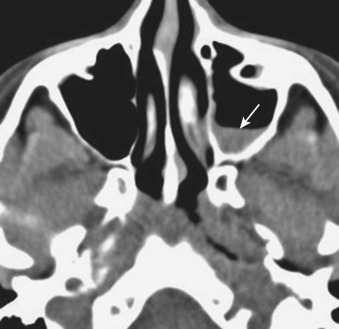
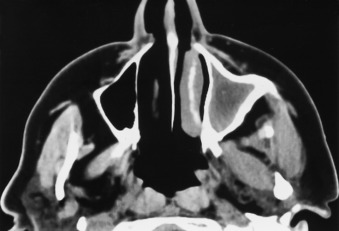
Hyperdense secretions on CT may be due to four main causes: (1) inspissated secretions, (2) fungal sinusitis, (3) hemorrhage in the sinus, and (4) calcification. The hyperdense sinus may be the only clue to fungal sinusitis and is an important feature to note. However, chronically inflamed sinuses infected with bacteria occasionally show hyperdense contents on CT, particularly in patients who have very long-standing disease, polyposis, or cystic fibrosis. A hyperdense sinus often corresponds to a hypointense sinus on T2WI ( Fig. 12-15 ).
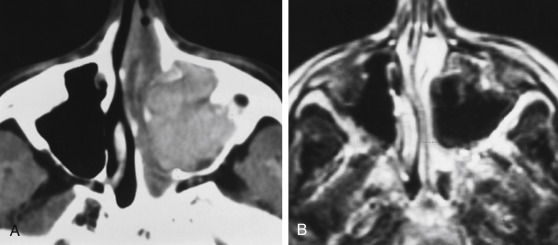
If you measure the Hounsfield units (HU) you can gain some specificity to the “hyperdense sinus.” Those with HUs greater than 2000 have a 93.3% chance of maxillary sinus aspergillosis. The mean CT density of the sinus concretions without aspergillosis is 778 HU. Make sure this hyperdensity is not reflective of hemorrhage secondary to a traumatized sinus.
The following features of the “calcified” sinus mass have been reported. A single discrete hyperdensity is most likely to be an inflammatory mass (aspergilloma, rhinolith), but multiple discrete calcifications could be seen in tumors (enchondromas, inverted papillomas, meningiomas) or inflammatory lesions. If the intrasinus calcification is central, fine, and punctate-like, it is most likely attributable to fungi. If the calcification is peripheral, curvilinear, and eggshell-like, it is probably nonfungal. If the process is diffusely hyperdense with a well-defined margin, think of a fibroosseous lesion but if it is poorly marginated, consider a high-grade sarcoma (chondrosarcoma, osteosarcoma). Although calcification is not unusual in inverted papillomas it is more likely to be residual bone, not calcifications. By contrast, esthesioneuroblastomas have intrinsic calcifications.
A rhinolith (stone in the nose) is often attributable to a foreign body that has become lodged in the nose and has slowly calcified. This may occur in the setting of traumatic or recreational nasal septum injuries.
While you are evaluating coronal CT scans for sinusitis, do not forget to look at four other related areas: the teeth, sella, nasopharynx, and temporomandibular joints. Maxillary periodontal disease can incite sinus inflammation (odontogenic sinusitis), and therefore thinning and/or dehiscence of the maxillary alveolus adjacent to an inflamed carious tooth necessitates reporting. The sinus disease will not resolve until the offending tooth is removed.
Malocclusions or temporomandibular joint degenerative change may indicate a maxillofacial pain syndrome that may simulate pain from sinusitis. Look for narrowing, osteophytes, or sclerosis at the joint.
Beware of the incidental sellar lesions and nasopharyngeal carcinomas that might be appreciable on routine sinus CT. When these tumors extend into paranasal sinuses, they can simulate the appearance of ho-hum sinus opacification—don’t be fooled! On that note, do not forget to evaluate the imaged portions of the brain for intracranial pathology—all kinds of sneaky buggers might be lurking there and will remain undetected unless you look for them.
Screening sinus CT images are often performed before bone marrow transplantation (BMT) in patients with hematologic malignancies. Of those showing severe sinusitis on initial screening CT scans, two thirds experience clinical sinusitis post-BMT. The presence of sinusitis on pre-BMT studies is also associated with a trend toward overall decreased survival.
Trauma often affects the walls of the paranasal sinuses. Remember that the floor of the orbit serves as the roof of the maxillary sinus, so orbital floor fractures cause blood levels in the sinuses. Similarly, the medial wall blowout fracture affects the ethmoid sinus and orbital roof fractures may affect supraorbital ethmoid cells or the frontal sinus. Direct blows to the forehead may cause inward displacement fractures of the frontal sinuses ( Fig. 12-16 ). Skull base fractures may cross the sphenoid sinus. These air-filled spaces are not necessarily the best buttresses against trauma, being very thin and with nothing but air between them and the directed force.
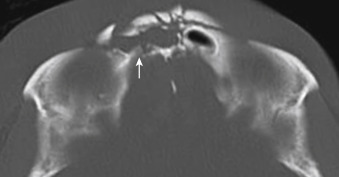
The sensitivity of MR to mucosal thickening accounts for the visualization of the normal nasal cycle. There is cyclical passive congestion and decongestion of each side of the nasal turbinates, nasal septum, and ethmoid air cell mucosa that rotates from side to side over the course of 1 to 8 hours in humans. Thus, 1 to 2 mm of ethmoid sinus mucosal thickening may not be due to inflammatory disease but may reflect the normal intermittent congestion of the nasal cycle. Be aware of the nasal cycle so you do not overread increased mucosal signal from the turbinates and ethmoid sinus as disease on MR. Even if you use 5 mm of thickness of the mucosa or greater as a determinant of pathology on MR, incidental sinus inflammation is present in more than 32% of asymptomatic patients coming to MR scanning.
Sinonasal secretions are often, but not always, bright on T2WI and dark on T1WI. The change in signal intensity of sinonasal secretions is based on protein concentration and mobile water protons. The changes are probably a result of the increased cross-linking of glycoproteins in hyperproteinaceous secretions, leading to fewer available free water protons and more bound protons to glycoproteins. As protein concentration increases, the signal intensity on T1WI of sinus secretions changes from hypointense to hyperintense, to hypointense again. On T2WI, hypoproteinaceous watery secretions are initially bright, but as the protein concentration and viscosity increase, the signal intensity on T2WI decreases. Therefore, you can get four confusing intensity patterns for sinus secretions: (1) hypointense on T1WI and hyperintense on T2WI in the most liquid form, (2) hyperintense on T1WI and hyperintense on T2WI in the mild-to-moderate proteinaceous form, (3) hyperintense on T1WI and hypointense on T2WI in a highly proteinaceous form, and (4) hypointense on T1WI and hypointense on T2WI when the secretions are in a nearly solid form ( Fig. 12-17 ).
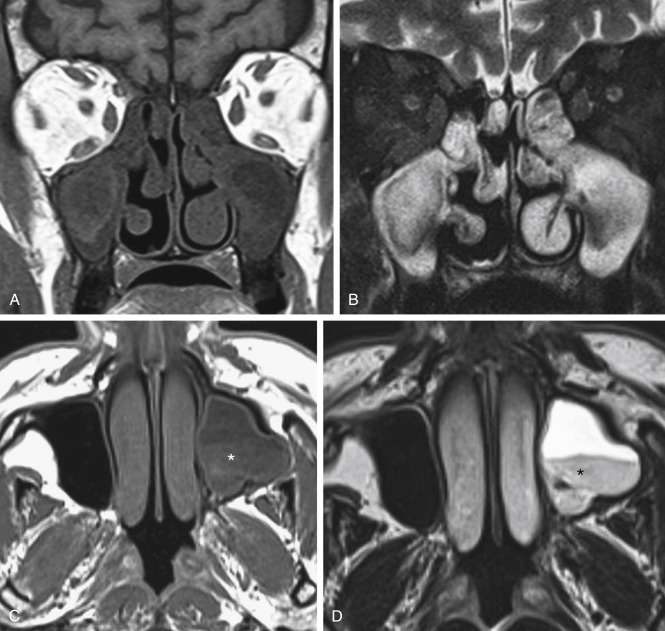
Because air and very hyperproteinaceous secretions appear as a signal void, this is a potential pitfall. You may think the sinus is aerated but it is not. Other potential problems in which hypointensity may be encountered on both T1WI and T2WI include osteomas, odontogenic lesions, osteochondromas, fibrosis, and fungal sinusitis mycetomas. The low signal of fungal sinusitis is thought to result from the paramagnetic effects of either iron or manganese metabolized by the fungi ( Box 12-4 ).
Teeth
Inspissated secretions
Fungus balls
Osteomas
Sinoliths
Hemorrhage
Odontogenic lesions
Chondroid lesions
Amyloidomas
Fibrosis
Because obstructed sinus secretions may have any combination of signal intensities, it may become difficult to distinguish inflammation from neoplasm solely based on intensity patterns. For this reason, the presence of peripheral rim enhancement is a reassuring finding that suggests inflammation rather than neoplasm (which enhances centrally).
There is one classification for types of FESS that is worth remembering; see Table 12-2 . Although postoperative studies will show open OMCs in patients with chronic sinusitis and polyposis, the overall extent of sinus opacification before and after FESS is more often than not minimally changed ( Fig. 12-18 ).
| Type | Uncinate Resected? | Ethmoidectomy | Maxillary Sinus Surgery |
|---|---|---|---|
| I | Yes | Only agger nasi cells | No |
| II | Yes | Bulla, anterior ethmoidectomy, frontal sinus opening | No |
| III | Yes | Bulla ethmoidectomy, frontal sinus opening | Antrostomy |
| IV | Yes | Anterior and posterior ethmoidectomy | Antrostomy |
| V | Yes | Anterior and posterior ethmoidectomy plus sphenoidectomy | Antrostomy |

CT is the study of choice in the acute setting of orbital complications after FESS, which usually occur within 48 hours after surgery. CT is reliable in diagnosing an orbital hematoma, assessing for optic nerve compression or inadvertent resection, and planning therapy to relieve increased intraorbital pressure. Often, however, if vision is deteriorating rapidly, this complication is treated on the basis of clinical findings. Acute hematomas are usually hyperdense on CT; occasionally, diffuse orbital fat edema may be the most salient finding. Usually, orbital hematomas are due to transection of an ethmoidal artery at FESS. The artery then retracts into the orbit and continues to bleed. The intraorbital pressure rises with the expanding hematoma, leading to compromise of the flow of the retinal artery and ischemia of the optic nerve. Decompressive canthotomies are emergently performed (within hours), or irreversible nerve damage will occur.
Other complications include trauma to the medial wall of the orbit. While removing the middle turbinate, the lateral attachment to the lamina papyracea (the basal lamella) may be yanked off and injure the medial wall of the orbit. Contusion to the medial rectus muscle, fat herniation into the sinus, and orbital hematomas may follow. Orbital emphysema may be seen.
CSF leaks resulting from trauma to the cribriform plate and damage from overvigorous removal of the superior attachment of the middle turbinate at the fovea ethmoidalis are other potential FESS complications. This may lead to postoperative meningitis, epidural abscess, or pneumocephalus. Fortunately, FESS surgeons are getting good at patching their own dural holes with mucosal free grafts or septal flaps.
Osteoplastic frontal sinus grafts are often placed during frontal sinus obliterative procedures when FESS has been unsuccessful in opening the frontal recess. Postoperatively, patients may develop pain that may be secondary to neuromas, mucoceles, or recurrent sinusitis if the sinus is not plugged completely. Most surgeons use fat to obliterate the sinus. MR imaging with fat suppression can evaluate the frontal sinus after obliteration with adipose tissue to look for mucoceles and to differentiate viable adipose tissue from fat necrosis in the form of oil cysts. The amount of fat intensity in the sinus obliteration decreases over time as fibrosis occurs.
Sarcoidosis may affect the sinonasal cavity and is one of the sources of nasal septal perforation (along with cocaine abuse, syphilis, leprosy, and granulomatosis with polyangiitis [formerly Wegener granulomatosis]) ( Fig. 12-19 ). The entities of lethal midline granuloma, Stewart syndrome, midline granuloma syndrome, polymorphic reticulosis, lymphomatoid granulomatosis, and pseudolymphoma have recently been reclassified into cases of granulomatosis with polyangiitis and/or non-Hodgkin T-cell lymphoma. The generic term of “midline destructive lesions of the sinonasal tract” has also been applied to these entities ( Box 12-5 ). Both granulomatous disease processes and non-Hodgkin T-cell lymphoma may present with nasal septal perforations, bony/skull base erosions, and soft-tissue masses in the sinonasal cavity.
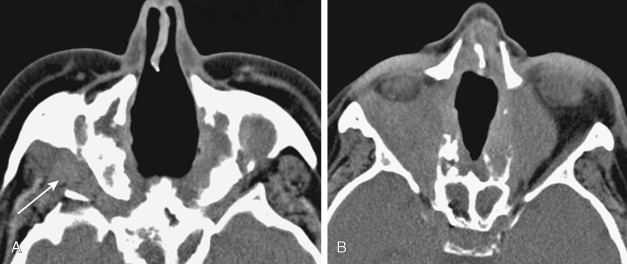
Cocaine
Iatrogenic
Foreign body reaction
Sarcoidosis
Granulomatosis with polyangiitis (formerly Wegener granulomatosis)
Lymphoma/prelymphoma
Tuberculosis
Syphilis
Rhinoscleroma (Klebsiella)
Leprosy
Granulomatous disease processes show intracranial involvement in up to 5% of cases, usually manifesting with cranial neuropathies. Meningeal inflammation, vasculitis, and hypophysitis may also coexist.
In cases of non-Hodgkin T-cell lymphoma, bony erosion may be seen, particularly involving the medial wall of the maxillary antrum or the hard palate. Relative preservation of the sinus morphology in the setting of a sinus soft-tissue mass can favor lymphoma over carcinoma, which results in frank destruction of the sinus walls.
Foreign body granuloma, polyarteritis nodosa, lupus, and hypersensitivity angiitis may also present with destructive sinonasal masses. Pseudotumor, an idiopathic inflammatory disease characterized by fibroblasts, histiocytes, and inflammatory cells, can simulate an aggressive sinus process. Pseudotumor has been more recently classified under IgG4-related disease, and can be associated with rhinosinusitis with or without bony destruction; patients have high levels of serum IgG4 levels and respond well to glucocorticoid treatment.
Become a Clinical Tree membership for Full access and enjoy Unlimited articles
If you are a member. Log in here